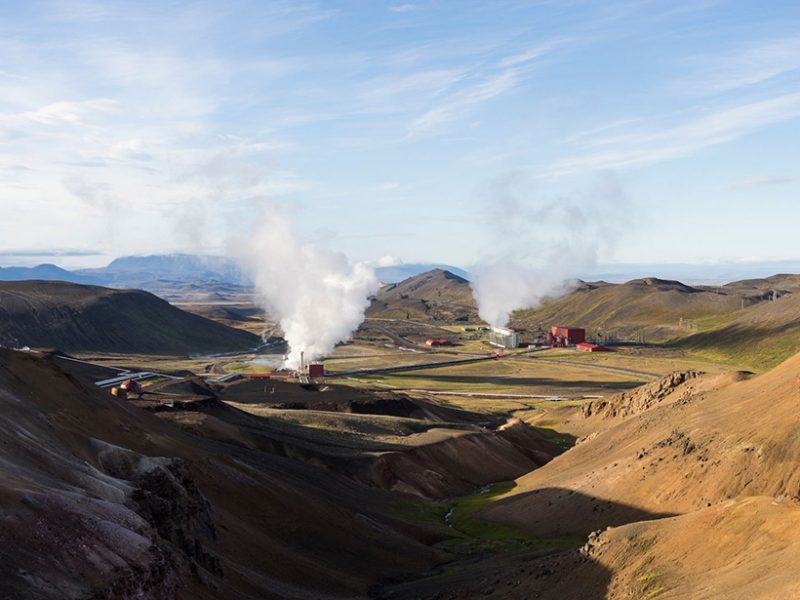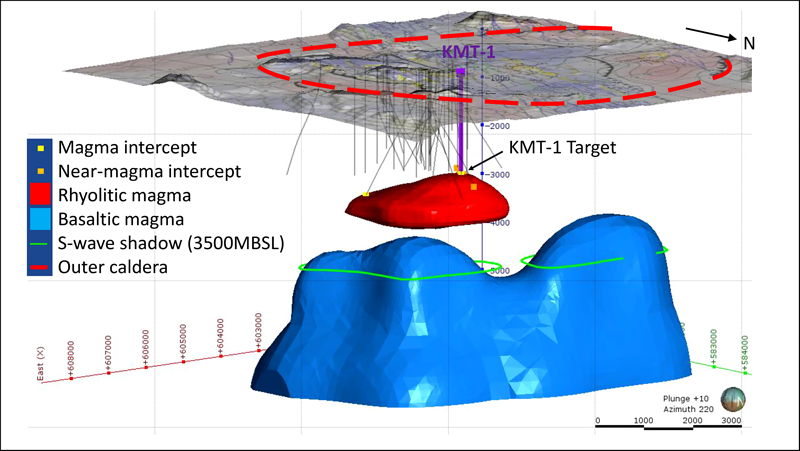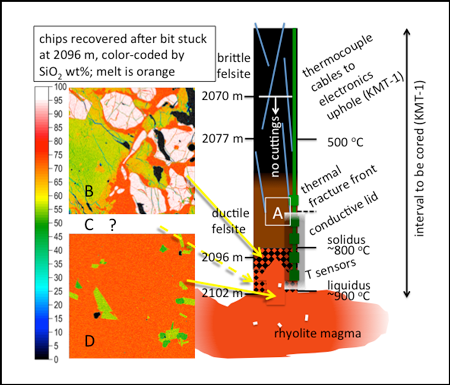O OVGA é um Centro de Ciência que desenvolve atividade de investigação aplicada e de divulgação científica na área da Vulcanologia, da Sismologia e da Geotermia.
Notícia -A A +A
Planning an International Magma Observatory - Notícia OVGA 16-09-2019

View from the north of the Krafla power plant in Iceland’s Krafla caldera. The plant generates 60 megawatts of electricity and is operated by Landsvirkjun, the National Power Company of Iceland.
Credit: Landsvirkjun
A planned project will drill into a magma reservoir in Iceland that has never erupted to the surface, giving scientists a fresh look at Earth’s underground “plumbing.”
Magma is the final frontier of Earth’s crust. It is unexplored for good reasons: Extreme temperatures and pressures impede access by scientists and their instruments. Further, no geophysical technique has been shown to satisfactorily locate magma reservoirs. Thus, drilling down to magma might seem impossible. At several sites, however, geothermal energy drilling operations have discovered magma accidentally and safely. One of these sites is Krafla caldera in Iceland.
Beginning in 2014, an international group of scientists and engineers developed a plan, the Krafla Magma Testbed (KMT), to conduct long-term exploration of Krafla’s rhyolite magma reservoir and its surrounding hydrothermal envelope. Our intent is to build surface facilities and subsurface magma portals where independent research teams can conduct experiments. The levels of funding required and the “user facility” organizational structure make such infrastructure analogous to that for telescope arrays and particle accelerators.
We have established a project office in Reykjavík at the Geothermal Research Group Cluster. Research institutes and companies from countries around the world, along with the government of Iceland, have endorsed KMT. We are optimistic that funding for the KMT project will begin within a year and that the facility, once built, can be maintained in an open state for decades.
Intentionally drilling into a magma reservoir is unprecedented, but projects to drill molten rock are not new. Beginning in the 1960s, the U.S. Geological Survey (USGS) began coring into lava lakes on Kīlauea volcano in Hawaii. Foremost among these projects was Kīlauea Iki, a pit crater that had erupted and filled with lava to a depth of 130 meters in 1959. Using small coring rigs, scientists drilled through the crust to the molten zone, retrieving almost perfect core samples. Cold water flowing through the core bit solidified the melt portion into beautiful glass but preserved it unchanged chemically.
Coring of Kīlauea Iki began soon after the eruption ended and continued to 1988, when the last of the melt lens was crystallizing. By the late 1970s, USGS was joined by Sandia National Laboratories in an effort to test the feasibility of extracting energy from magma. In essence, Kīlauea Iki became a test bed of the sort that we envision for unerupted rhyolite magma at Krafla.
The results of the Kīlauea Iki project were transformational in magma science. Scientists obtained repeated petrologic profiles that traced the melt in time, composition, and space [Helz and Thornber, 1987]. Repeated temperature profiles showed that thermal fracturing at the base of the growing crust allowed water and steam circulation to rapidly transfer heat out of the melt lens [Hardee, 1980].
The location of Kīlauea Iki’s still-molten lava was obvious because it had pooled at the surface, but all discoveries of unerupted magma have been unexpected and serendipitous. The first such discovery began with geothermal drilling into the Kīlauea East Rift in 2005 [Teplow et al., 2009]. After passing through a zone of solid diorite, the drilling encountered crystal-poor dacite magma at a depth of 2,488 meters. The magma flowed 8 meters up the well.
At Menengai caldera in Kenya, geothermal drilling began in 2011, and multiple wells have since penetrated syenitic magma 2 kilometers beneath the caldera floor [Mbia et al., 2015]. Not only were these magma bodies or body surprisingly shallow, but also none of this magma had erupted in recent times.
At the Kīlauea East Rift and Menengai sites, as well as at the Krafla site, there is a heat-conductive “magma lid”: an abrupt transition zone from solid rock to molten rock and a correspondingly extreme temperature gradient as predicted by Carrigan [1984]. An upper “mush zone” of partially crystallized magma, typically seen in lava lakes, is missing.
All of these accidental encounters also share another common feature. Because hydrostatic pressure exerted by the drilling fluid in the borehole is much less than lithostatic pressure on the magma exerted by the overlying rock layers, magma begins to ascend up the borehole. The cold drilling fluid quickly quenches the viscous magma, forming a rock plug. These magma encounters were unexpected, and thus, no measurements or core samples were taken.
In order to use magma (or avoid accidental encounters), geophysical techniques must be developed into accurate prospecting tools by testing them against known magma targets with known properties [e.g., Kim et al., 2019]. The results of unexpected magma encounters also warn against assuming that ash and lava from eruptions fully represent the range of magmas beneath a volcano. These are two of the research challenges that our magma observatory project aims to address.
We chose Krafla caldera for our observatory project (Figure 1) because Iceland Deep Drilling Project‘s IDDP-1 drill hole and some 40 geothermal wells drilled before it have already provided a wealth of descriptive information about this site [e.g., Mortensen et al., 2014]. The Krafla caldera geothermal development project of Landsvirkjun, the National Power Company of Iceland, encountered its first unequivocal penetration of magma in 2007. In 2009, IDDP-1 encountered near-liquidus rhyolite at 2,102 meters, and magma flowed 9 meters up the well.

Fig.1 - Simplified schematic of the magma system beneath Krafla caldera (dashed red line), showing boreholes drilled for geothermal development (gray). The location of one large, near-liquid rhyolite magma body (red) is based on data from the intersection and near-intersection points with the boreholes, as shown. The rhyolite body sits above a region of basaltic magma (blue). The rhyolite and basalt regions may be more complex, with multiple smaller bodies of magma. The planned KMT-1 borehole (purple) closely follows the path of the earlier IDDP-1 project.
Credit: J. W. Catley
Other wells at Krafla have reached magma or near magma over an area of 3.5 square kilometers. The roof rock (rock layer just above the magma) at IDDP-1 is partially melted felsite (Figure 2). IDDP-1 recorded exceptionally high permeability above the magma, contradicting researchers’ expectation that roof rock would be ductile and therefore impermeable. The resultant long-term flow rates of superheated steam, if channeled to a power station, could produce more than 30 megawatts of electricity from this single well.
Plans for the KMT Observatory
Krafla is the site of the most drilling, geoscience, and monitoring of any magma-hydrothermal system worldwide because of its volcanism, rifting at a major tectonic plate boundary, and robust production of geothermal energy. The public-spirited nature of the field operator, Landsvirkjun, the National Power Company of Iceland (LV), and a supportive local population present an exceptional opportunity for broad science, engineering, and community collaboration.
KMT will be built in phases of increasing complexity, with the first estimated to cost $25 million and the total development to cost some $100 million. For phase I we plan to do the following:
- choose the well site close to IDDP-1 so that we drill through the same rock layers
- drill the well and case it to about 2,050 meters using novel flexible couplings to accommodate thermal expansion and contraction
- core ahead until we penetrate magma
- emplace a thermocouple string to the bottom of the hole
- install a wellhead with a port for insertion of further experiments and pressurize the well with nitrogen to maintain an open hole
Subsequent drilling will provide a time series of observations for the magma-hydrothermal boundary, that is, whether the boundary is getting deeper as the system cools or is rising as the system heats up. We also plan to test extreme sensors (which are also relevant to such applications as aircraft engines and missions to Venus and Io) as well as the casing alloys and cements needed to ensure the long-term operational life spans of superhot boreholes. We will explore spatial variations in the magma body and its envelope and methods of extracting energy from this heat source.

Fig. 2. KMT-1 will provide the first cored transect of the margin of a magma chamber and the first measurement of heat flow from magma to a hydrothermal system. Results, observed and inferred, from IDDP-1 [Mortensen et al., 2014] are shown here, along with plans for KMT-1 assuming a similar section. A is felsite, B is partially melted felsite, C is crystal-rich rhyolite magma (“mush” that was expected but not observed), and D is near-liquidus rhyolite. Images B and D are element maps from N. Graham and P. Izbekov at University of Alaska Fairbanks’s Advanced Instrumentation Laboratory, color-coded according to silicon dioxide (SiO2) weight percent. Orange is rhyolite melt (now glass) with 75 weight percent SiO2. In image B, it has formed along grain boundaries between plagioclase feldspar (lime green) and quartz (white, 100 SiO2 weight percent). Black is void space. In image D, melt makes up most of the sample, within which euhedral plagioclase, pyroxene (dark green), and ilmenite (black) float. Each field of view is 1 × 1 millimeter. Data from KMT-1 will reveal the depth and temperature relationships of these materials, helping to solve the enigma of why extensively crystallized magma (at C) is not present, even though melting in the rock roof (image B) above the magma should approximately balance magma crystallization. One explanation might be that convection in the magma allows heat given off by crystallization to be extracted from a much larger volume of the magma relative to the volume of the melted static roof.
Putting the Knowledge to Use
The KMT observatory will be a rich source of scientific knowledge, but the knowledge we gain will find many practical applications as well.
Assessing volcano hazards is one obvious example of such an application. The first questions people ask about a dangerous volcano are whether there is magma and, if so, where it is. KMT provides a test of geophysics against (under)ground truth. At present, we rely on proxy signals such as microearthquakes and surface deformation that provide untested and nonunique interpretations of what the magma is doing. We will be able to manipulate the fluid pressure in the borehole to generate seismic signals to test our inferences of volcano “unrest.” Ultimately, development of in situ sensors that can detect pressure and temperature changes within a magma reservoir preceding an eruption will yield a vast improvement in the reliability of eruption forecasting.
The geothermal energy industry can also benefit from the KMT observatory. Iceland, one of the hottest regions of Earth’s crust, is an ideal location for an international test bed to accelerate advances in geothermal energy production. Geothermal energy has the least surface footprint of any energy source, usually produces little or no carbon dioxide (CO2), and is continuous (“bed load”).
Ten percent of the human population lives less than 100 kilometers from active volcanoes [Newhall et al., 2017]. Areas near magma are the best places to find high-energy aqueous fluids: superheated or supercritical hydrothermal fluids that transport heat rapidly to the surface [Scott et al., 2017]. At these fluid conditions, the efficiency of converting heat to electric power approaches the level of hydrocarbon-fired power plants [Tester et al., 2007] but without the problem of carbon-based fuels.
KMT can also help to address some fundamental science questions about how the magma-hydrothermal regime works. Both the absence of magma mush at the chamber roof and the high permeability of what should be ductile, impermeable rock near the magma [Mortensen et al., 2014] pose enigmas. The simplest explanation for the absence of crystal-rich magma mush is convection [Carrigan, 1984]. The simplest explanation for high permeability is thermal fracturing [Lamur et al., 2018]. These conclusions suggest a tightly coupled system in which magma rapidly advects (transports) heat to the solidified lid over the magma chamber. Cooling causes contraction, which fractures the lid, keeping it thin and heat conducting. High-energy fluids generated in the fractures can then transport this heat to a power plant. Such a system is efficient and sustainable.
The KMT project will also contribute to planetary science by serving as an analogue to similar sites on other planets. Rocky planets differentiate (separate into layers of different composition) when melts separate from crystals and these components float or sink. By tracking melting and crystallization in situ, KMT will provide the first view of the final stages of planetary differentiation.
We are developing multiple levels of educational experiences for this unprecedented journey to inner space. For example, through work at the University of Canterbury more than 4,000 students have already taken a virtual field trip to Krafla or played Magma Drillers Save Planet Earth, an online game that lets students plan a geothermal energy drilling site (Figure 3).
 Past experience, albeit accidental, shows that we can reach and sample magma. Undertaking a planned rather than an accidental journey to magma is imperative for discovering new fundamental insights, mitigating the perils of eruption disasters, and developing energy alternatives to the hydrocarbon fuels currently poisoning the atmosphere with CO2.
Past experience, albeit accidental, shows that we can reach and sample magma. Undertaking a planned rather than an accidental journey to magma is imperative for discovering new fundamental insights, mitigating the perils of eruption disasters, and developing energy alternatives to the hydrocarbon fuels currently poisoning the atmosphere with CO2.

Fig. 3. Students play Magma Drillers, an online game that teaches them basic principles of drilling, geothermal energy, and volcano monitoring, as well as the career paths required. Credit: Ben Kennedy and Jonathan Davidson (design), Elizabeth Moredensky (art)
Fonte: eos.org (25-06-2019)
Adenda OVGA:
Localização do Complexo Vulcânico Krafla (Islândia)
Diversos elementos da equipa OVGA já trabalharam na caldeira de Krafla (pronuncia-se “Krabla”) e assistiram a sondagens de 2.000 m de profundidade.
